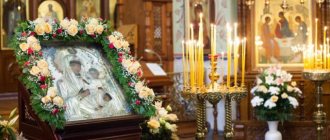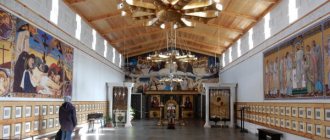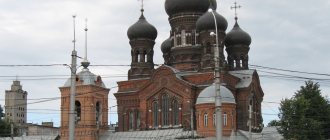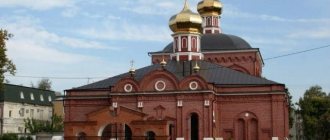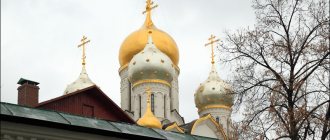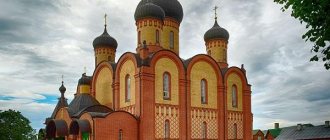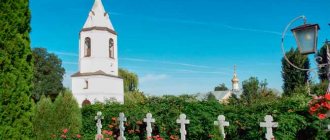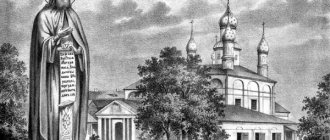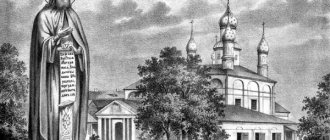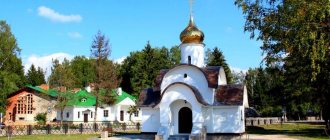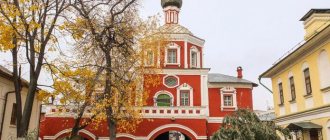Biblical wisdom teaches that a city cannot stand if it does not have at least three righteous people. That is, true strength does not lie in squads and military strength, but in God’s help, sent down through the prayers of holy saints. The Russian people understood this well, and therefore spared no expense and labor in the construction of holy monasteries, which became not only a stronghold of Orthodoxy, but also an inexhaustible source of spiritual purity and morality. Our story will be about one of these monasteries, built on the banks of the Volga.
Fortress Samara town
Nowadays Samara is one of the largest cities in the Middle Volga region. Its history goes back more than four centuries. In 1586, during the reign of Tsar Fyodor Ioannovich, a fortress, the Samara town, was founded on the Volga bank. The time was turbulent, so a guard stronghold was needed to block the path of the steppe nomads. There also arose a holy monastery, called the Spaso-Preobrazhensky Convent. The warriors stood with weapons in their hands at the border of the Russian land, and the monastery sisters offered prayers for the overcoming of the adversaries.
This continued until 1764, when the monastery was abolished due to the small number of nuns. The absence of a spiritual center so necessary for life could not but have an impact. In the first half of the next century, the 19th century, trends towards church schism intensified in society. In addition, various sects became widespread, the most active of which were representatives of the so-called Molokan heresy.
Monastic way of life
The life of the nuns was not very diverse: the main task was prayer. It was divided into church or general and home: nuns along with icons were invited to perform the ceremony in homes.
See also: Diveevo Monastery official website. Moscow region, holy springs
Women also carried out obediences: they read the psalter, prepared food and prosphora, did needlework (sewing, icon painting), taught at school, looked after the sick, and sang in the choir. In addition to generally useful tasks, women worked “for themselves”: clothes, light and heat were paid out of their own pockets.
This is interesting: local nuns embroidered the Samara banner, which was transferred to the Bulgarians in the Russian-Turkish War.
Today's life is practically no different from that described above. The only exception is the need to conduct excursions and receive pilgrims.
The need to create a monastery
To counter such phenomena, it was necessary to create a powerful stronghold of true Orthodoxy. For this purpose, the residents of Samara turned to the Holy Synod with the initiative to open a convent in the city, designed for about a hundred nuns. Having supported the idea of the Samara people, the leadership of the Synod, however, demanded specific information about what funds were planned to be used to build the monastery.
This problem was solved in the old proven way - they announced a collection of donations among the city residents for the construction of the monastery. Particularly respected and religiously minded citizens of the city formed a board of trustees, which took over the organizational part of the enterprise, and several of the richest representatives of the city society made large monetary donations and, importantly, allocated land plots belonging to them for the construction of the monastery.
Creation of a women's community
The founding date of the monastery is considered to be 1850, when a chapel was built in which all-night vigils were held. To send them, the parables of two churches that then existed in the city were used - the Kazan Cathedral and the Trinity Church. Over time, eight cells were built around the chapel, in which those who wanted to devote their lives to serving God settled.
From these first nuns, a small community was formed in 1852, for the care of which a priest was appointed. The pious maiden Maria Yanova became her abbess. This choice was very successful, since she subsequently proved herself to be an energetic and talented organizer. Thanks to her work, an intensive process of community development began.
Transformation of the women's community into a monastery
Three years later, the first church of the future monastery was built and consecrated, and soon another one, consecrated in honor of the Mother of God of Jerusalem, opened its doors to parishioners on its lower floor. This happened in July 1857. However, this was only the beginning of extensive construction work. A year later, through the care of the board of trustees of the diocesan authorities and the abbess of the community herself, a large stone church in the name of the Presentation of the Lord was laid.
Of course, such zeal on the part of those who devoted themselves to this pious cause, and such an intensive pace of community development could not but cause the most positive reaction from the leadership of the Holy Synod. The consequence of this was the transformation of the women's community into a monastery in 1860, which was called the Iversky Convent. Samara thus received a much-needed stronghold of spirituality and religious enlightenment.
Iversky Convent of Samara Diocesan monasteries of the Russian Orthodox Church
In 1586, by decree of Tsar Feodor Ioannovich, a fortress was founded on the right bank of the Samara River, which was named after the Samara River. The builder of the new fortress was the governor Grigory Osipovich Zasekin, a descendant of the Rurikovichs and Chingizids. The new fortress was supposed to protect the eastern borders of the Russian state from the Nogai Tatars. Simultaneously with the foundation of the fortress, a wooden Orthodox church was laid. It was consecrated in honor of the Life-Giving Trinity, and the chapel in honor of St. Nicholas of Myra. And then the Spaso-Preobrazhensky Monastery was built.
Gradually the settlement spread along the left bank of the Volga River. In 1688, the Samara fortress became a city.
At that time Samara was not rich in churches, but the spirit of piety was alive among its inhabitants; in the forties of the 19th century, Samara residents had the idea of establishing a convent in the city for supposedly one hundred sisters. By that time, a whole century had passed since the Transfiguration Convent of the Savior was disbanded and its fourteen nuns, together with the abbess, found shelter in the Simbirsk Monastery.
Almost a century has passed, but the memory of the Transfiguration Monastery in the city remains alive and girls and widows appeared in Samara who wanted to devote their lives to God. In imitation of the monastic image, they wore black clothes, lived separately and piously under the leadership of the priest of the Assumption Church S. M. Belsky, and were called blueberries.
The sisters received support and help in their good endeavors from the pious family of Mikhail Ivanovich and Elena Lvovna Fedorov. Together with the Archpriest of the Kazan Cathedral, Ioann Khalkolivanov, the Fedorovs managed to inspire the Samara residents with the idea of creating a monastery in Samara. The collection of donations for the future convent has begun.
Fedorov served as a county land surveyor and not out of excess, but out of love for God, donated a plot of land that belonged to him on Mechetnaya (now Samarskaya) Street for the community. But this place was far from the water, which would certainly make life difficult for the community. Then new benefactors were found. Merchants Pyotr Sergeevich Sinyagin and Mikhail Ivanovich Nazarov donated the coastal strip of land adjacent to the Volga River, and Elena Lvovna Fedorova, her mother, the official Praskovya Aleksandrovna Sukhova, and Mikhail Fedorov’s sister Olga Ivanovna Timasheva donated places on the hill adjacent to this strip. “Samara Diocesan Gazette” noted on this matter: “For the good of the community, a donation of places was being prepared, which was difficult to expect and foresee, but which directly indicated the special care of God’s Providence in relation to the community in the early stages of its inception.” The place was flat, convenient for building cells and growing a vegetable garden.
More than thirty girls and widows aged from 22 to 60 gathered at the donated place to live together. Among the first sisters there were two noblewomen, three soldiers, seven bourgeois women, one Cossack woman, eight merchants and two clergy. Having received the blessing of the archpastor, they chose from their midst the bourgeois maiden Maria Yakovlevna Yanova to lead them. To guide the external and internal order, lifestyle and behavior of the sisters, the community was given rules approved in 1842 by the Holy Synod for the Arzamas, Ardatov, Zelenogorsk and Diveevo women's Orthodox dormitories located in the Nizhny Novgorod diocese. These rules consisted of 49 paragraphs that determined the order of services, lifestyle and relationships of nuns.
In 1850, the religious procession, which was traditionally held for the Exaltation of the Holy Cross in Samara, at the request of the community trustees, came to the site of the future monastery. Bishop Feodoty (Ozerov) of Simbirsk and Samara, having performed a prayer service for water, sprinkled this territory with holy water. After erecting the cross, he laid the first stone at the foundation of the chapel and blessed the sisters with the icon of the Jerusalem Mother of God, thus entrusting the emerging monastery to the protection and patronage of the Queen of Heaven. This day is considered the beginning of the Samara Iversky Convent. The first thing the sisters did was to collect stones for the foundation on the shore. Two months later, in November, the chapel in honor of the Kazan Icon of the Mother of God was already built and consecrated, and evening services and hours immediately began to be held in it. First, the clergy of the Kazan Cathedral was assigned to the Kazan chapel, then the clergy of the Trinity Church. During the first all-night vigil, a demon-possessed girl was healed from the Jerusalem icon of the Most Holy Theotokos, donated to the community by His Grace Theodotius.
The sisters who entered the community in the first years of its existence doomed themselves to extreme labor, since it did not have constant and lasting support and existed only on donations. The nascent monastery could not hope for increased material assistance from the townspeople. In Samara in the middle of the 19th century there were about 15,000 inhabitants, among whom there was not a single outstanding rich man. At that time the city had little trade. There were no merchants of the first guild there at all. Even in the second guild in Samara there were only eight families. Of the city's 2,324 houses, four-fifths were wooden, and many resembled real shacks. The people who started the business of organizing the community had rather limited funds themselves. In addition to Archpriest I. E. Khalkolivanov and M. I. Fedorov, the title of trustees of the community was assumed by middle-class merchants P. G. Baranov and G. V. Gavrilov and the even less wealthy postmaster G. P. Bogoroditsky.
Poverty and scarcity were everywhere. The first nuns had to have great selflessness, strong, indestructible faith and love for the Savior, and unquenchable zeal for the exploits of monastic life. Each of them was obliged to set up her own cell at her own expense and fully support herself by doing handicrafts. But they were happy because they could devote their lives to the Lord and live in joyful communion with God under the protection of the Mother of God.
In 1853, the provincial authorities decided to build a road along the Volga through the area where the women's community was located. In exchange, the sisters were offered a plot of land on the hillside, and the monastery was finally settled there. By that time, it had already gathered 75 women and girls, who, through labor and alms, collected up to 7,060 rubles in money and various deposits of about five thousand, thereby laying the material foundation for the official approval of the community. The highest decision was made on March 12, 1855. The opening of a women's community in Samara was considered not only useful, but also necessary. Like other charitable institutions, it remained at its own expense, without any assistance from the treasury. The community was named Iveron, fulfilling the wish of the Elabuga merchant Ekaterina Ivanovna Marikhina, who donated a family shrine to the monastery - the Iveron Icon of the Mother of God with valuable gold plating.
By the time the community was recognized, the Kazan Chapel was rebuilt into a temple. On April 4, 1855, His Grace Eusebius performed the rite of great consecration of the renovated church and named it in honor of the Iveron Icon of the Mother of God. From that time on, a clergyman was assigned to the monastery and the Divine Liturgy began. Two years later, another small temple was built and consecrated under the Iveron Church - in honor of the Jerusalem Icon of the Mother of God - for the celebration of early Liturgies. The first priest in the Iveron community since 1853 was Stepan Vasilyevich Pospelov. Two years later, the clergy was promoted to a deacon, and from 1858 to a second priest. Subsequently, the monastery staff included two deacons and two priests. The clergy of the Iversky Monastery at different times were: Evgeniy Nikolaevich Tychin (years of service: 1855–1858), Ioann Gerasimovich Piksanov (1858–1859), Nikita Illarionovich Saltykovsky (1859–1866), Fyodor Ivanovich Blagovidov (1859–1866), Dmitry Nikolaevich Orlov (1859–1867), Konstantin Georgievich Dobroserdov (1867–1878), Georgy Ivanovich Tretyakov (1867–1904), Pyotr Stepanovich Arkhangelsky (1881–1895), Vasily Yakovlevich Mayeranov (1896–1901).
In pre-revolutionary 1916, the clergy of the Iversky Monastery were Archpriest Gabriel Mikhailovich Farmakovsky (served in the monastery since 1878) and priests Vasily Aleksandrovich Uspensky (in the monastery - since 1901) and Pavel Georgievich Tretyakov (son of Archpriest Georgy Tretyakov, in the monastery - since 1904) .
The wooden Iveron Church had a modest appearance. Sheathed with planks and painted brown with oil paint, it was oblong in shape. The entrance from the lower porch led on both sides of the stairs to the upper landing by several steps. On the upper platform there was an entrance to a narrow corridor where there were two cells. In one of them there was a sister guarding the temple, in the other there was a continuous reading of the Psalter. Through the cell where the Psalter was read, there was an entrance to the choir and a room for the abbess. The ceiling of the temple was supported by tetrahedral columns. Two of them, standing closer to the pulpit, were painted with holy images. The church was illuminated by thirteen windows, but since it was obscured by mountains on both sides, there was a lack of light in it. The iconostasis in two tiers of carpentry, with gilded carvings on a white background, was built by the Samara merchant Vasily Andreevich Golovachev. On the left side of the royal doors was the Iveron Icon of the Mother of God. Behind the left choir was the especially revered Jerusalem Icon of the Mother of God.
The altar was spacious. On a high place stood a large icon of the Most Holy Trinity with the Mother of God, holy saints and angels standing below. This icon, donated by His Grace Eusebius, is painted on canvas and placed in a gilded frame with the same carvings.
The daily celebration of Divine services, strict observance of the rules of the Church, the harmonious singing of the choristers, cleanliness, neatness and order attracted many pilgrims to the monastery from all sides, who carried with them feasible sacrifices. The permanent source of income for the community was the land donated by benefactors in the Zhiguli Mountains, which was rented out, as well as the cemetery established at the community for the burial of lay people. In addition, the diocesan authorities allowed the Jerusalem Icon of the Mother of God, famous for its miracles, to be taken into the homes of Samara residents for prayer services, accompanied by clergy and singers. This also brought income to the monastery.
Since the community received the official right to exist, more active construction began. In just over a year, several buildings were built on stone foundations, houses with outbuildings for the clergy, and a building with the same services for the abbess herself. When joining the community, the sisters not only made contributions according to their means, but also pledged to build a cell for themselves. In this way, from 20 to 40 sisters, folding, built buildings, divided into several cells, in each of which lived from one to four sisters. Soon the question arose about building a large stone temple in the monastery. His Eminence Theophilus (Nadezhdin), who by that time had replaced Bishop Eusebius at the Samara see, blessed this undertaking and on September 17, 1858, consecrated the site of future construction. Having laid the foundation stone for the Presentation Church, the head of the Samara diocese uttered a heartfelt word in which he recalled that the holy churches of God are places where we receive the grace-filled gifts of the Holy Spirit in the saving Sacraments; here we offer prayers before the Lord and fulfill vows, just as righteous Anna and the parents of the Blessed Virgin Mary did. Recalling biblical stories, Bishop Theophilus instructed the nuns of the Iveron community to strictly and strictly fulfill the vows they had given to work for the Lord with fear and trembling.
It is significant that the foundation of the temple coincided with the day when the Holy Church celebrates the representatives of the three Christian virtues of Faith, Hope, Love and their mother Sophia - wisdom, without which neither temporary well-being, nor, especially, eternal salvation can be created. The plan for the construction of a three-altar church was drawn up by the provincial architect K. G. Maker in the Russian-Byzantine style. Construction lasted more than ten years. This majestic temple had a cruciform shape, its vaults rested on six columns. The length and height of the building were more than forty meters, the width was about thirty meters. The temple was crowned with a dome with five pear-shaped domes, of which the middle one stood out for its large size. Three entrances - from the west, south and north - were made of white stone, each entrance had seventeen steps. The walls were decorated with white marble, the altar was lined with marble and multi-tiered carved iconostases were installed.
The monastery did not have the funds for such a significant construction, but the construction of the temple was completed. The Samara merchant, city mayor Vasily Efimovich Bureev became the trustee of this charitable cause. Other benefactors also contributed. For example, the merchant and member of the Samara City Duma Ivan Mikhailovich Pleshanov donated more than 10,000 rubles, and at his own expense also ordered two iconostases with many icons. On March 24, 1860, His Eminence Theophilus (Nadezhdin) entered the Holy Synod with a proposal to raise the Iveron community to the level of a monastery and to tonsure the abbess and other sisters of the community into monasticism. This document noted the desire of Samara residents to have a monastery in their city: “Taking into account the zealous desire of Samara citizens and sisters of the community to see this community at the level of a monastery and the need for its existence in the newly settled Samara diocese, I have the honor to most humbly petition the Holy Synod for the construction of a monastery located in the city Samara community to the level of a cenobitic monastery, without the assignment of a salary from the treasury, but with the allocation, for the maintenance of it, land and other lands, about which correspondence is already underway with the civil authorities, and who have already agreed to such an allocation.” On July 6, 1860, Emperor Alexander II approved the determination of the Holy Synod on the elevation of the Iveron women's community to the level of a monastery. On August 13, the first monastic tonsure took place: the monastic monk of the cross church of the bishop's house, Macarius, named the abbess of the monastery Maria Yanov Margarita.
On August 21, the community held a Divine Service with the Bishop's Rite. The small wooden church of the monastery could not accommodate all the pilgrims. His Grace Theophilus, Bishop of Samara and Stavropol, solemnly celebrated the Divine Liturgy. Concelebrating with him were the rector of the seminary, cathedral archpriest Ioann Khalkolivanov and other priests. After the Liturgy, the Synodal Decree on renaming the community into a monastery was read, and a prayer of thanks was offered. Before leaving the church, His Grace handed the newly installed abbess Margarita a staff and wished that “in all the exploits of monasticism, she would show herself as an example and example of all Christian virtues, and especially those with which monasticism should be embellished.”
At the end of August, the first twenty sisters of the monastery were tonsured into the mantle. To the rules that had hitherto determined the life of the community, the diocesan authorities added seventeen points taken from the charter of the Saratov Monastery of the Exaltation of the Cross.
By this time, about two hundred nuns lived in the monastery. All of them supported themselves by their own labors: they were engaged in decorating and adorning icons, sewing vestments and clothes for clergy, and other handicrafts. In addition to the building for the abbess with a special room for needlewomen, there were eight nursing buildings, a building for clergy, a laundry, and cold buildings.
Behind the Iverskaya monastery, meadow lands and fishing areas were approved. A monastic farm settled on land rented from the city by a benefactor. Through the efforts of noblewoman Maria Alekseevna Vasilyeva, a common meal was established for the sisters. They developed their own workshops: gold embroidery, icon painting, embossing, white embroidery, carpet, priestly clothing and vestments, bookbinding, shoe making and others. At the head of each workshop was a nun or a cassock novice, under their subordination there were from eight to twelve young novices, and in the seamstress - much more. The gold-embroidery workshop was subordinate to the abbess of the monastery, who herself was an excellent gold-embroidery worker. Abbess Margarita sat day and night at work, wanting to decorate the icon of the Mother of God “Quick to Hear,” which was donated to the Iveron monastery by a Christ-loving elder monk, who brought it from Athos, with embroidered pearls with expensive diamonds, yachts and topazes. By September 8, 1869, the arrangement of the temple in honor of the Presentation of the Lord was completed and the consecration of its main altar took place. But Divine services had already been held since the fall of 1867 in the chapel, consecrated in the name of the supreme apostles Peter and Paul. The third chapel, in honor of St. Sergius of Radonezh, was built only thirty years later.
In July 1874, 67-year-old Abbess Margarita, having served as head of the monastery for a quarter of a century, retired for health reasons. During her ministry, she did a lot for the formation and development of the monastery in Samara. Through her prayers, constant efforts and deeds, a small society of cell maidens and widows was formed into a legalized monastic community.
The second abbess of the Samara Iversky Monastery was the forty-three-year-old treasurer, nun Antonina (in the world – Anastasia Ivanovna Rozalieva). On the Nativity of the Most Holy Theotokos in 1874, she was elevated to the rank of abbess by His Grace Gerasim (Dobroserdov).
At that time, the monastery was already decorated with the majestic Sretensky Church, but the newly appointed abbess was faced with new tasks. The new church had no heating, and services could only be held in the warm season. Therefore, the monastery needed to build a vast, warm stone temple. The extremely cramped wooden churches of the Iveron and Jerusalem Icons of the Mother of God needed to be immediately expanded. Residential buildings and outbuildings required urgent repairs. The construction of the monastery fence continued. All this required significant funds, which the monastery did not have. But the Mother of God, the Patroness of the monastery, every time a need arose, arranged it so that benefactors would suddenly appear.
During the abbess of Mother Antonina, according to God’s will, the Alabin family became one of the constant and major benefactors of the monastery. Pyotr Vladimirovich Alabin came from the Ryazan nobility and, according to family tradition, became a military man. In 1849, as part of the Kamchatka Jaeger Regiment, he took part in the campaign of Russian troops in Hungary, then in the Danube Campaign of 1853 and in the famous defense of Sevastopol during the Crimean War. For participation in these military campaigns, Alabin was awarded the Order of St. Anne, 3rd and 4th degrees, and the Order of St. Stanislav, 2nd and 3rd degrees. Later, based on his war diaries, he published the three-volume book “Four Wars. Hiking notes."
In 1857, Pyotr Vladimirovich ended his military career and transferred to Vyatka, where he was soon appointed to the position of manager of the specific provincial department. In 1866, the Samara period of Alabin’s life began. He was transferred to Samara as the manager of the provincial chamber of state property, and in 1884 he was elected City Mayor. Under him, the city budget increased by 400 thousand rubles, active greening of the city began, the Lebedev iron foundry, the Vishnyakov oil mill, the Shchelokov printing house, the Pasteur station, a meteorological station, a city water supply system, a city theater, the Volga match factory, and a brick factory were built and began to operate. Zhukov, Bashkirov's steam flour mill, Grebezhev's confectionery factory, Ulasov's soap factory. For the first time in Samara, gas was used for lighting, the first telephone exchange with ten numbers began operating, and construction of the Cathedral continued. In 1874, Pyotr Vladimirovich and Varvara Vasilyevna Alabins built a chapel church in the Iversky Monastery over the grave of their early deceased daughter Elena in the name of the Holy Equal-to-the-Apostles Queen Elena and the Great Martyr Varvara, and due to this the Iversky Church was expanded. Through the efforts of the Alabins and other benefactors they attracted, a chapel was built near the railway station according to the design of the architect M. I. de Rochefort in memory of the successful outcome from the famine disaster of 187374. On April 9, 1877, on the day volunteers were sent to General M. G. Chernyaev in Serbia, Bishop of Samara and Stavropol Gerasim (Dobroserdov) consecrated a chapel in honor of the Iveron Icon of the Mother of God. Thus the Lord miraculously completed the construction of the monastery.
And the right people were sent to build a stone bell tower with a temple in it in the name of St. Nicholas, the Wonderworker of Myra. On September 8, 1877, the foundation stone of the bell tower took place. In 1879, in its middle tier, a temple in the name of St. Nicholas of Myra was consecrated, and in 1881 a cross was erected on the bell tower and the bells were raised. The bell tower was 60 meters high, with a shining cross and a sonorous bell of more than five hundred pounds.
In 1891, according to the spiritual will of the deceased merchant V. A. Golovachev, the monastery received five hundred acres of good-quality arable land seventy miles from Samara, near the Chagrinsky Monastery. A farmstead was later established on this site. They installed a horse-drawn mill in the barnyard to grind their grain bread; they renewed and installed all the outbuildings both in the monastery and on the farmsteads. In the early spring of 1882, work began. A mountain was dug into the required space, forming a flat platform in the shape of the letter P. The earthen walls, to protect them from atmospheric influences, from which they could crumble, were lined with a stone fence of considerable height. The temple had the shape of a parallelepiped, stretched from west to east, and had two pillars. The building ended with a massive dome with ten windows in a drum and was crowned with a small dome. The crosses were made of an iron rod, covered with red sheet copper and gilded. The height of the temple with the dome and cross was 30 meters. On the western side, a white limestone terrace was made along the entire length of the façade. The appearance of the temple was quite modest: the planes of the facade had no protruding parts, were separated by vertical pilasters, and the planes of the walls in the center were crowned with triangular pediments. It was dedicated to the Iveron Icon, and a chapel was built in honor of the Archangel Michael and consecrated on June 29 of the same year. In 1886, water supply was installed in the monastery. Two years later, in honor of the 900th anniversary of the Baptism of Rus', a wooden chapel was founded near the Strukovsky Garden in honor of Equal-to-the-Apostles Prince Vladimir. Later it was rebuilt in stone. On the day of the Nativity of the Blessed Virgin Mary, September 8, 1889, a church school for one hundred girls was opened in a bright and spacious building near the bell tower. In the same year, the fencing of the monastery with a stone wall was completed. It was about three meters high, with four gates and towers at the corners. At the southern gate there was a stone bell tower. Particularly revered icons were kept in the temples of the monastery: the gift of the Right Reverend Theodotius, the holy image of the Mother of God of Jerusalem in a silver gilded robe, the Iveron icon of the Mother of God in a golden robe with diamonds and emeralds, and the icon of the Mother of God “Three-Handed”, painted on a cypress board by Athonite monks, in a silver gilded robe. After the death of Mother Antonina, the sisters chose nun Feofania (Alexandra Matveevna Nemertsalova), who had previously been treasurer, who became the third abbess of the Iveron Monastery.
During the abbess of Mother Theophania, the Iveron Monastery was visited several times by the well-known and revered pastor John of Kronstadt throughout Orthodox Russia. On July 27, 1894, at about eight o’clock in the evening, in front of a huge crowd of people, Father John performed a prayer service for water in the monastery’s large church. The second time Saint John of Kronstadt visited the monastery was on July 13, 1897, the third time on January 19, 1902. On this last visit, he served a prayer service in the monastery and exhorted the sisters to pray more.
On May 9, 1902, after a major renovation of the Sretensky Church, Bishop Gury reconsecrated its main altar in honor of the Dormition of the Mother of God. This was due to the fact that the Presentation of the Lord is celebrated in winter, and the temple was cold and it was not possible to hold the patronal feast. At the beginning of the twentieth century, the monastery had several well-maintained charitable institutions. The monastery had its own hospital. Medicines and doctor’s advice could be used not only by sisters, but also by school students, pilgrims, and the poorest population of the city. There was a garden inside the fence, and extensive necropolises near the Sretensky and refectory churches.
In September 1908, Abbess Feofania, by decision of the consistory commission, was retired. In her place, nun Seraphim (in the world - Anastasia Vasilievna Milovidova) was appointed sacristan of the monastery.
In the monastery registers of 1916, there were 437 sisters from ten to one hundred years old, of which: two abbess, two schema-monitors, 100 were tonsured into the mantle, 187 were tonsured into monasticism, and 146 novices. In 1918, there were already 500 sisters living in the monastery. These were mostly peasant girls from the Samara province. The usual expression from monastery records, “I learned to read and write in my parents’ house,” most often concealed only the ability to read. On November 20, 1918, along with other clergy, the priest of the Iversky Monastery, Pavel Georgievich Tretyakov, was shot. On the way to execution they sang a dirge for themselves. In 1919, the Iversky Monastery was closed as a religious organization, but the sisters did not leave, but formed a sewing artel and registered a community of believers. The churches were preserved as parish churches; Iveron, Jerusalem and St. Nicholas parishes were registered. During the Civil War, the residential buildings began to be occupied by Red Army soldiers of the 98th regiment, then the unemployed began to move into the monastery buildings. The commandant of the headquarters of the Turkestan Front petitioned in October 1919: “During our inspection together with the chairman of the Housing Department of the Iversky Convent, it turned out that it was possible to make a large compaction in the monastery, freeing up about 50 rooms. Since the housing crisis has reached unprecedented severity in Samara, I ask for permission to densify the said monastery, and would propose to vacate one of the buildings, so that the nuns will be isolated, which is what they mainly strive for.” The compaction, carried out at a very hasty pace, reached the point of absurdity when, for example, a Red Army soldier was placed in a cell with several elderly nuns.
All silver and gold valuables - vestments from the especially revered icons of Jerusalem, the Iveron Mother of God, an altar cross, a large ark, two lamps, a silver chalice, ten more icons and other objects - were confiscated from the monastery in the 20s and transferred to the provincial financial department. On the part of the monastery, the act was signed by the treasurer, nun Manefa. The sisters gave up their church values unconditionally, hoping in this way to help people dying from the famine that broke out in 1921. About a thousand people died every month from exhaustion in the Samara province. Bread was made from buckwheat husks, from the roots of swamp plants, and birch catkins, but there was still not enough of it. In Samara in the fall of 1921, a diocesan committee to provide assistance to the hungry was created. Members of the clergy of the Iversky Convent, Archpriests P. M. Arkhangelsky and A. F. Bechin, Protodeacon V. S. Gorbunov were administratively sentenced at the end of December 1921 to a term of six months to a year for participating in this committee, created without proper permission from the authorities.
In 1922, the monastery was already defined as former in the documents of Soviet provincial organizations. Most of the residential buildings were occupied as apartments by workers from Vodosvet and the Metallist society. From that time on, the monastery territory began to be called the Workers' Town. On July 28, 1924, on the basis of a resolution of the commission for registration of religious societies, the chapel of the Iveron Mother of God, located at the railway station, was taken away from the monastery and transferred to the renovationists. The Vladimir Chapel near the Strukovsky Garden was adapted for housing. It was planned to set up a club and a gym in the Iversky and Assumption churches, and in Kazan - a children's hearth. On December 31, 1929, after the closure of these churches, the monastery ceased to exist. The Iversky Church was given over to a club. Later, the Samaraoblobubyt workshops were located here. A garage for the Transport society was set up in the Assumption Cathedral. A year later, the cathedral was blown up and a residential building for regional committee workers was built in its place. At the same time, the bell tower was destroyed.
The bricks obtained from the blown-up Cathedral and the churches of the Iversky and Nikolaevsky monasteries were used for the construction of new buildings.
On June 18, 1930, the City Council adopted a resolution “On the sale of monuments, crosses, grilles and tombstones within the city limits.” In accordance with this decree, the fence, crypts, and graves were destroyed in the Iverskaya monastery. They began to pave Aleksandrovskaya (now Vilonovskaya) Street with tombstones from the monastery cemetery. Next to the grave of P.V. Alabin in the family crypt of Prince Kugushev, an outdoor toilet and garbage disposal were installed.
In 1933, on Alekseevskaya Square (now Revolution Square) on the night of November 7-8, the burning of liturgical books, icons and vestments took place. On the territory of the Iversky Monastery on February 8, 1938, the rector of the Iversky Church, Archpriest Peter Mikhailovich Arkhangelsky, and Protodeacon Nestor were brutally killed - bayoneted and drowned in an ice hole on the Volga. Parish priests, monks and believers were arrested and exiled. In 1930, Archpriest Alexander Fedorovich Bechin was sentenced to five years in concentration camps for counter-revolutionary activities. In 1937, the confessor of the Iveron monastery, Hieromonk Ilarius (Ovinov), was arrested and then shot.
On December 6, 1991, the community of the Iversky Monastery was registered. On February 13, 1992, she was given 0.79 hectares of land with the Refectory Church, the abbess’s house and a former craft workshop. Before the revolution, the monastery territory was much larger, the monastery occupied 8 dessiatines, or 8.7 hectares. In Soviet times, the mountainous part was built up with residential buildings and buildings that housed institutions, and no one hopes for its return, although since the beginning of the 90s the monastery's holdings have expanded a little.
On February 24, 1993, on the eve of the feast of the Iveron Icon of the Mother of God, Archbishop Eusebius of Samara and Syzran performed the first Divine Service in the Refectory Church since the closure of the monastery. At the same time, the main shrine of the Samara monastery became the Iveron icon of the Athos script, donated by the Bishop, which had previously been kept in the altar of the Intercession Cathedral. The townspeople brought many icons. Often these were holy images simply executed on hewn boards in three or four colors, decorated with foil. Some of the icons and the library were transferred from the house in which Metropolitan Manuel (Lemeshevsky) spent the last years of his life; it was destroyed at exactly the same time - in February 1993.
In August of the following year, nun Ioanna (Kapitantseva) was appointed abbess in Samara.
In 1995, the Iveron Cathedral building was returned to the monastery's jurisdiction. In fact, only the walls remained of this temple, so there were even proposals to build it again. Restoration work began with the creation of a retaining wall at the base of the steep slope facing the temple. After this, the foundation and walls were strengthened. Inside the church, four columns were installed supporting the drum of the dome. In October 1999, the Iversky Monastery was visited by His Holiness Patriarch of Moscow and All Rus' Alexy II († December 5, 2008).
The restoration of the cathedral began to move faster when in 2000 the Government of the Samara region adopted a plan for the comprehensive revival of the Iversky Monastery.
The most noticeable building in the Iverskaya monastery for all residents of the city and for tourists who sail on ships along the Volga, of course, can be considered the 57-meter bell tower. This is an exact copy of the pre-revolutionary monastery bell tower, which for a long time was the hallmark of the city of Samara. As before the revolution, a church was built above the holy gates in the name of St. Nicholas the Wonderworker.
Next to the bell tower there is a worship cross in honor of the holy Equal-to-the-Apostles Methodius and Cyril, the first teachers of Slovenia.
Since 2001, the monastery has housed the relics of the locally revered Saint Alexander of Chagrinsky.
The monastery received a compound in the Volzhsky region.
Organization of the economic life of the new monastery
Shortly before this solemn event, the abbess of the community, Maria Yanova, took monastic vows with the name Maragarita and, thanks to her merits, was elevated to the rank of abbess of the new monastery. Soon the other sisters were also tonsured. From surviving documents it is clear that in 1860 the Iversky Convent in Samara was inhabited by twenty nuns and one hundred and ninety novices. For a newly opened monastery this is quite a lot. It is known that many monasteries at their founding had a much smaller number of inhabitants.
From the first days of its existence, the Iversky Monastery (Samara) had to independently ensure its existence. The fact is that it belonged to the category of cenobitic non-staff monasteries and did not receive any subsidies for its maintenance. Of course, some part of the necessary funds came from voluntary donors and in the form of payment for various religious activities, such as long-term commemorations of the deceased, reading the Psalter in private homes, etc. But the sisters’ main income was the money they earned in the numerous workshops opened at the monastery.
It is known that icons were painted here and chasubles were minted for them, church vestments were sewn and decorated with skillful gold embroidery, carpets were woven and elegant clothes were sewn for the women of the city. Even such purely male crafts as shoemaking and bookbinding turned out to be within the power of female hands. It was thanks to the hard work of its nuns and the generosity of its donors that the Iveron Monastery (Samara) lived and developed.
Description and location
The monastery is located on the left bank of the Volga.
At first it stood almost on the shore, now the area is separated from the water by residential buildings. Before the revolution, it was in charge of a huge territory, but with the advent of the USSR it was taken away and residential buildings were built on half of it.
It is important to know: the appearance of the monastery largely determined the view of Samara from the Volga side.
Externally, the monastery is very elegant: all buildings are made of red brick with white decorations and golden domes. There are many trees and flowers on the territory, and paths are laid out for convenience.
We bring to your attention an informative article about the Vyshensky Assumption Convent and St. Theophan the Recluse.
Abbess Antonina and her works
Since 1874, Abbess Antonina has become the abbess of the monastery, instead of Mother Margarita, who retired after twenty-five years of service. In former times, she served as the monastery treasurer. Like her predecessor, Mother Antonina made an invaluable contribution to organizing the life of the monastery. As a result of her efforts, in 1882 the construction of a warm stone church began in the name of the Tver Icon of the Mother of God. Six years later, the temple was solemnly consecrated, and regular services began to be held there.
But one of the main innovations, initiated by Abbess Antonina, was the construction of a spacious two-story hospital at the monastery. This project was realized thanks to the generous donations of the Samara merchant P. Shikhobalova, who transferred all the necessary funds to the Iversky Monastery (Samara). Two years later, in 1889, also through the efforts of the abbess, a parochial school was opened in the monastery, in which about a hundred girls from bourgeois and peasant families were constantly studying, and an orphanage for orphan girls was created under it.
Current state
Today there are several restored churches, a bell tower, 2 sisters’ buildings, a rector’s and a guest building, a refectory church, and a worship cross in memory of Cyril and Methodius.
Also, a necropolis was reopened on the territory, where eminent Samara residents were reburied, a monument to the public figure Alabin and the grave of Archpriest John Bukotkin were erected.
There are several workshops on the territory of the monastery:
- Zolotosveynaya: it was located here before the revolution and was revived after the 90s;
- Sewing: mainly vestments for priests, cassocks and clothes for the nuns themselves are sewn;
- Icon painting: the sisters do everything themselves, they also restore the icon;
- Publishing: this is a new but promising direction. A monthly newspaper, booklets, symbols and albums dedicated to the monastery are printed here.
At the beginning of the 21st century, 65 nuns live on the territory, including 10 nuns, 30 novices, 22 nuns and 3 schema-nuns.
Last years before the revolution
Abbess Antonina went to the Lord in 1892 and was buried in the Church of the Tver Icon of the Mother of God, to the construction of which she put so much mental and physical strength. Her place was taken by the nun Feofania, who had previously served as treasurer, just like her, but six years later she was removed from this position and gave way to the priestly widow A.V. Milovidova, who took the name of Seraphim in monasticism. Over the next years, she led the monastery, skillfully combining spiritual and economic activities. Under her leadership, the Iversky Monastery (Samara) faced the dramatic events of 1917.
It should be noted that by this period the monastery had achieved a lot in its development. There were four temples on its territory. Services in the Iversky Monastery (Samara) were attended by both the nuns of the monastery and the residents of the city. In addition, the monastery was famous for its well-maintained charitable institutions, among which were: a hospital, a parochial school, a shelter for orphan girls and a hospice. The total number of inhabitants of the monastery in 1917 exceeded four hundred people.
Photo of the monastery
- The monastery is also visible from the other bank of the Moscow River.
- After the resumption of services in St. Nicholas Cathedral, the monastery is gradually being rebuilt.
- The architectural ensemble looks especially majestic at night.
- During the day, the monastery gates are open to all believers.
- The Iveron Cathedral, where the Iveron Icon of the Mother of God was located, amazes with its size and beauty.
- It was in the St. Nicholas Church that prayer began for the first time after the monastery was closed during the Soviet years.
Period of religious persecution
In the years following the October Revolution, the monastery shared the fate of many Russian monasteries. In 1919 it was stripped of its status as a religious institution. Of the ten residential premises, most were given over to communal apartments for employees of local enterprises.
Individual church buildings, originally provided for worship to the local Orthodox community, were repurposed for economic needs, and the central monastery church - the Assumption Cathedral - and its 65-meter bell tower were blown up. The Iversky Monastery (Samara) interrupted its activities for many years. The schedule of services of those years testified only to the continuation of prayer service within the framework of the religious community, while the monastery itself was abolished.
How to get to the Nikolo-Perervinsky Monastery
You can get to this monastery either by your own vehicle or by public transport. In the latter case, there are three options:
- get to the Tekstilshchiki metro station, and then transfer to bus No. 703 or 161;
- take minibus No. 38M;
- get to the Pechatniki metro station, and then take buses No. 161, 292, 703.
You should get off buses and minibuses at the Nikolo-Perervinsky Monastery stop.
Revival of the holy monastery
The revival of the holy monastery began in the nineties, when all over the country everything that had been illegally taken from it during the hard times was returned to the church. In 1991, a women's community was re-organized and the premises of the refectory church were given to them. Since that time, active restoration work began. A lot had to be built anew, recreating the appearance from surviving photographs and memories of old residents of the city.
The Iversky Monastery (Samara) now stands above the Volga in its former glory. Reviews from pilgrims and tourists who visited it indicate that the work of builders, restorers, and simply volunteers who wished to participate in its revival was not in vain. In 1994, the women's community formed on its territory received the official status of a monastery. From that time until the present day, it is headed by Abbess Ioanna (Kapitantseva).
How to get there
Address of the monastery: 344064, Rostov-on-Don, st. Neklinovskaya, 4 You can get there from the Central Market along Budennovsky Avenue Avt. No. 83 to the “Sovkhoz” stop. And from the main railway station by minibus to Ave. Budennovsky, then aut. No. 83 to the “Sovkhoz” stop.
The best article for you, go to: Nikolo-Ugreshsky Monastery where it is located, how to get there, address, schedule of services
May the Lord protect you!
You will also be interested in watching a video about the holy Rostov monastery:
